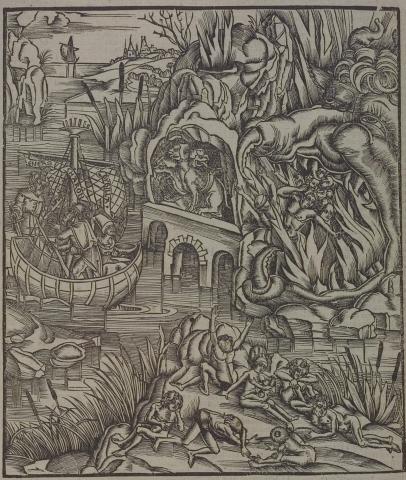Annotations
On the left, Aeneas, standing next to the ferry of Charon, shows the golden bough to the ferryman, as proof that he has permission to enter the depths of the underworld; in Vergil, the Sibyl holds the bough (406-10). Charon prepares to ferry Aeneas and the Sibyl across the Styx (407-16). The water is marshy (414-6), which is indicated by the cattails. In the middle of the image the three-headed dog Cerberus growls from its cave, where it guards the entrance to the deeper underworld (417-25). In the upper right, shades are crowded inside the fiery jaws of Hell, which is depicted as a monstrous head. It is interesting to note that the design of the monster is entirely different from the depiction of the same monster in the previous image. On a spit of land between the two primary rivers, more souls sit despairing; these may be the shades whom Charon displaced from his boat in order to carry Aeneas and the Sibyl (411-3).
Woodcut illustration from the “Strasbourg Vergil,” edited by Sebastian Brant: Publii Virgilii Maronis Opera cum quinque vulgatis commentariis expolitissimisque figuris atque imaginibus nuper per Sebastianum Brant superadditis (Strasbourg: Johannis Grieninger, 1502), fol. 268v, executed by an anonymous engraver under the direction of Brant.


Sebastian Brant (1458-1521) was a humanist scholar of many competencies. Trained in classics and law at the University of Basel, Brant later lectured in jurisprudence there and practiced law in his native city of Strasbourg. While his satirical poem Das Narrenschiff won him considerable standing as a writer, his role in the transmission of Virgil to the Renaissance was at least as important. In 1502 he and Strasbourg printer Johannes Grüninger produced a major edition of Virgil’s works, along with Donatus’ Life and the commentaries of Servius, Landino, and Calderini, with more than two hundred woodcut illustrations. (Annabel Patterson)